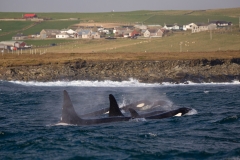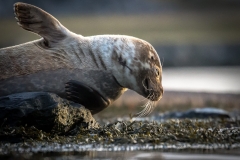Shetland is renowned for its rich and diverse wildlife. In terms of sealife, seals, porpoises and orcas (killer whales) can be regularly spotted at any location. Otters are more elusive creatures but they are active at many Shetland coastal locations.
When it comes to birdlife, Shetland truly is world class and the south mainland is no exception. Birds can be spotted almost anywhere at any time but there are a number of popular and renowned bird watching sites nearby:

Loch of Spiggie Nature Reserve (2 miles) is important for a variety of waterfowl but is perhaps best known for attracting large numbers of whooper swans in autumn and winter. A new bird hide was constructed at the north end of the loch in 2022 allowing visitors to view the local wildlife in sheltered surroundings.
Mousa Nature Reserve (7 miles) is located on the island of Mousa off the southeast coast of Shetland. It is home to a variety of seabirds but is notable for having one of the UK’s largest storm petrel colonies, many of which nest in the world renowned Mousa Broch. Passage to the island is provided by The Mousa Boat from Sandwick. Their popular dusk trips during late-May to mid-July to view the storm petrels must be booked in advance.

Sumburgh Head Nature Reserve (9 miles) is an important seabird colony that is home to thousands of seabirds during the breeding season including puffins, guillemots, razorbills, fulmars, kittiwakes and shags. It is also one of the best places in Shetland to watch for sea mammals.

For the ultimate wildlife watching experience, we recommend you book an excursion with an experienced tour operator. A list of operators can be found here.
When watching marine wildlife, whether from the shore or at sea, please remember to follow the Scottish Marine Wildlife Watching Code to avoid disturbance or harm to the animals.




